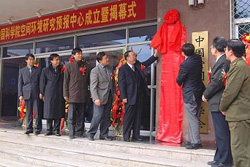
The opening ceremony for the newly established CAS Center for Space Environment Research and Prediction was held on Nov. 10 at CAS Center for Space Science and Applied Research. CAS Vice President Jiang Mianheng and Vice Minister of State Commission of Science, Technology and Industry for National Defense Luan Enjie officiated the ceremony.
Wu Ji, director of the Center, said its primary mission is to "dish out detailed data and effective analyses" which are vital to key national space programs.
A pioneer of space environment studies in China, CAS boasts comprehensive advantages in exploratory facilities for space environment, its data resources, qualified professionals, and research achievements. It has provided outstanding services for China's manned space mission and many satellites. In order to further pool research forces in the field to make strategic contributions to the space science and technology and national security of this country, CAS decided to form a loose consortium for space environment research and prediction, involving six CAS institutions undertaking studies into space environment, namely: Center for Space Science and Applied Research, National Astronomical Observatories, Wuhan Institute of Physics and Mathematics, Institute of Geology and Geophysics, University of Science and Technology of China, and Institute of Atmospheric Physics.
Establishing research units without a status of independent legal entity covering CAS institutes in interdisciplinary and major areas is an important attempt of CAS in institutional reform, says Prof. Jiang. They will function as a technical platform for various institutes to share resources and carry out joint research projects.







